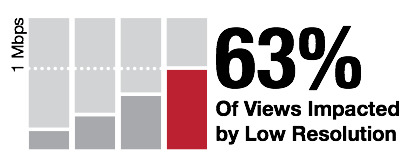Think Streaming Will Replace Cable TV? This Data On Streaming Quality Proves Otherwise
 These days, many want to suggest that cable TV offerings will be “killed” or “replaced” by content services being delivered over the Internet using content delivery networks. While that’s not reality, those who make these suggestions speak as if the quality of the content delivered online is the same as what consumers get from cable TV. However, thanks to Conviva, we have data from some of the largest streamers on the web, that shows how difficult it really is to deliver video on the Internet, with reliability. In fact, of the 22.6 billion streams Conviva monitored in 2012, 60% of them had quality issues. 60%!
These days, many want to suggest that cable TV offerings will be “killed” or “replaced” by content services being delivered over the Internet using content delivery networks. While that’s not reality, those who make these suggestions speak as if the quality of the content delivered online is the same as what consumers get from cable TV. However, thanks to Conviva, we have data from some of the largest streamers on the web, that shows how difficult it really is to deliver video on the Internet, with reliability. In fact, of the 22.6 billion streams Conviva monitored in 2012, 60% of them had quality issues. 60%!
The quality of online video isn’t even close to what cable TV delivers today when it comes to quality and reliability – yet many don’t want to admit this as it goes against their agenda. I like data because it proves what’s really going on in the market and when the sample size is so large, like what Conviva has shared, no rational person can argue with it. So rather than debate or speculate what may or may not work, we have the data to actually know.
In 2012, Conviva analyzed 22.6 billion streams for some of the largest content owners on the web including Netflix, ESPN, HBO, Viacom, VEVO, MLB, USA, NBC and many others. The data they share comes from content owners and syndicators who probably account for at least 75% of the video traffic on the web today, outside of Google. These content owners who use Conviva’s service add a small bit of code to their player, which allows Conviva to collect and monitor the user’s video experience, in real-time, and sends that data back to Conviva’s console. Last quarter, Conviva shared a lot of the data they collected in 2012 and here are some of the key findings:
- 60% of all streams experienced quality degradation. Viewer interruption from re-buffering affected 20.6% of streams, 19.5% were impacted by slow video startup and 40% were plagued by grainy or low-resolution picture quality caused by low bitrates.
- In 2011 a 1% increase in buffering resulted in 3 minutes less of viewing time per view of long-form content. In 2012, that identical 1% increase led to 8 minutes lost in viewing time per view for similar content.
- The start time for a video to launch is critical. If video start time exceeds 2 seconds, the number of people that abandon viewing dramatically increases—400% for long-form VOD and for live content, abandoned views increase 140%.
- Viewers with a buffer-free experience watch 226% more and are four times more likely to stay and watch if video starts in 2 seconds or less
- For live video streams, viewers not impacted by buffering watch 10 times longer.
- By improving buffering performance and video quality, a typical long form VOD provider, (with 10 million views per month) will increase revenue by as much as $1.4 million monthly.
- In 2012, 124.8 billion minutes were spent in buffering.
- More than 18% of viewers requesting a live stream abandoned before the video started—more than 4 times higher than long-form VOD.
Conviva’s data shows that a staggering 60% of views were impacted by stalls, low resolution or buffering. 39.3% of streams were impacted by buffering and 4% never started. That’s over 900 million streams that never started! Ironically, for all the talk of HD, Conviva’s data showed that many consumers are watching on a screen capable of displaying high-quality (HQ) video, yet 63% are viewing below HQ resolution. And when it comes to buffering, for a live event lasting 90 minutes, Conviva’s data showed that 10.8 minutes of that content didn’t work thanks to buffering. Can you imagine turning on the TV to watch a movie and not being able to see 12% of it? Consumers would not stand for it.
So for those that want to talk to cable TV as being some sort of outdated technology that’s going to get “replaced” by streaming media based services, we have the data to prove otherwise. It’s not up for debate. Cable TV is still able to deliver a better quality user experience, nearly every time, over Internet video. You may not like the price you have to pay for cable TV, but the technology still surpasses Internet video because it works, it’s easy to use and you know what HD means. On the web, anything goes and you never know what you will get, as Conviva’s data proves.
